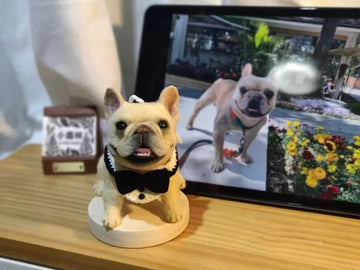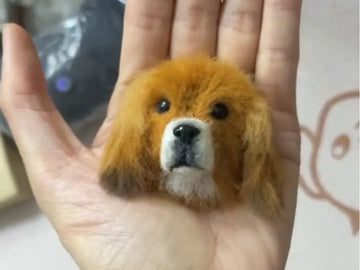Imagine shaping soft wool into a lifelike animal so vivid it seems ready to leap into your arms. This magic is real—through needle felting! With just a needle and fiber, your fingertips can sculpt charming creatures, from regal lions to adorable bunnies. Each stab transforms fluffy wool into detailed art, blending patience and creativity. Ready to unlock this craft? Let’s explore how simple tools and techniques bring stunning felted animals to life, one tiny poke at a time.

What Is Needle Felting Animals?
Needle felting is a craft where a barbed needle sculpts loose wool into 3D shapes. As you repeatedly poke the fibers, the barbs tangle and compact them, gradually forming a solid structure. With each precise stab, details emerge—fluffy fur, lifelike poses, and charming textures—transforming fluffy wool into realistic animals. This simple yet meticulous process turns raw fiber into stunning, handcrafted pet portrait.
Required Materials
Before diving into the process of needle felting animal, you’ll need just a few essential tools. Each material plays a key role—wool becomes your canvas, needles sculpt like tiny chisels, and a foam pad brings it all together. Here’s what needle felting animal kits to gather:
l Wool Roving: Choose high-quality wool roving—its long, soft yet durable fibers hold shape beautifully. Like clay in your hands, it molds effortlessly, almost wanting to become your creation. Perfect for both structure and fine details.

l Felting Needles: There are different types of animal needle felting kits. Thick needles, with large apertures and wide barb spacing, are great for quickly shaping the work's basic form at the start. Thin needles, with slender bodies and fine barbs, are used later to carve details like pet hair texture and facial expressions.
l Foam Pad: Foam pads transform needle-felting sessions. This sponge-textured work surface acts as both shock absorber—sparing your table from needle marks—and a springboard for precision. Its porous structure guides your stabs, letting you control depth and tilt effortlessly. The result? Wool fibers tame into shape as if weaving their own magic beneath your hands.
How Do You Needle Felt Animals? (Step by Step)
Creating pet portraits through needle felting is a journey that transforms raw materials into a heartwarming keepsake. Each step is a building block, gradually bringing your pet's unique charm to life. Now, let's delve into the detailed process.
Collecting Photos
High-quality, well-lit photos are key. They should show the pet's body clearly, avoiding shadows that hide details like hair texture and eye shine. Taking pet photos from multiple angles, such as front, side, and back, helps capture the pet's features and posture. Catching dynamic moments, like playing or resting, adds personality to the creation.
Sketching
Sketching a simple outline on paper before starting is useful. The sketch only needs to mark the pet's position and body part proportions, like the head-to-body ratio and limb postures. It gives a basic framework for shaping the wool roving, preventing proportion and composition issues.
Shaping the Basic Shape
Choose the right amount of wool roving and roughly knead it into a shape like the pet's body. For a cat, make an oval body and leave space for the head and limbs. For dogs, shape according to the breed. After that, a thick felting needle is used to pierce and compact the wool from one end to the other, gradually forming the body prototype.
Adding Body Details
For short-haired pets like Siamese cats and Chihuahuas, use a thin felting needle to pierce the wool along the hair's growth direction for a smooth look. For long-haired and fluffy pets like Alaskan Malamutes and Persian cats, first, use a thick needle to make the wool fluffy, then a thin one to adjust the hair's density and direction. To show hair color changes, mix different-colored wool rovings based on the pet's photo.
Shaping the Head and Face
Start by sculpting the head separately. Blend a small number of wool fibers at the neckline to create a seamless transition between head and body. For the face, layer light-colored fibers as the eye base; use dark fibers for pinpointing pupils, and refine details with an ultra-fine felting needle. Shape the nose and mouth by referring closely to your pet’s photos, capturing their unique expression through precise sculpting.
Adding Accessories (Optional)
If the pet has accessories like collars or bows, you can make them. For a leather-like collar, roll brown wool into a strip, compact it, and pierce it with a thick needle for texture. Then add decorations and make bows and hats in similar ways.
Secrets to a Professionally Finished Felt Needling Animals
l Blending and Smoothing the Wool
After felting, if the surface is uneven, cover it with a smooth cloth and press gently. You can also use a thin felting needle to flatten bumps, but be careful not to break the fibers. Use thick needles for shaping at first and thin ones for details later, like for pet whiskers.
l Fixing Mistakes
For uneven areas, use tweezers to pick up loose fibers and felt them. For over-felted parts, trim with scissors and then use a thin needle to blend. Always test in a hidden area first and control the tool's force.
l Fixing the Finished Portrait
Proper framing is important. Wooden frames suit a warm, natural look; metal frames are modern; plastic frames are practical. For large or formal works, use picture-frame framing. When framing, place the work flat, use glue carefully, and add fillers for 3D works. Make sure the frame size fits.
Conclusion
Felt needle animals sculptures turn craft sessions into joyful adventures – you'll discover wool's surprising personality while weaving affection into every fiber. This tactile art form beats canvas painting in accessibility, with materials costing less than a tube of oil paint. The sculptural magic? A lifelike presence that seems ready to nuzzle your hand.
For crafting realistic needle felted animals—whether delicate whiskers or that perfect nose wrinkle—PetDecorArt artisans work magic. Their breed-specific kits (think Persian cats to Dachshunds) simplify the process, but their true brilliance shines in bespoke creations. Simply send a photo of your pet, share your vision, and their skilled hands will transform wool into a lifelike tribute that immortalizes your companion’s unique charm.
Customize your own pet portrait↓↓↓




